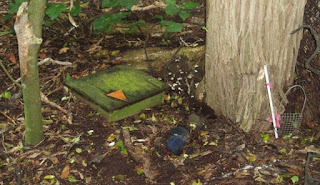This post is from Annette who has spent the last few weeks on Rangatira in the Chatham Islands. Hopefully she will do a report on the Black Robins when she gets a spare hour or three.
Report
from Annette
I have just spent a month on Rangatira, a Nature
Reserve in the Chatham Islands.
Our main task was to do a complete census of the
Black Robins, and band this year’s juveniles. However equally important, though
less time-consuming, was to band the Chatham Petrel chicks.
The Chatham petrel
(Pterodroma axillaris) is one of
New Zealand’s most endangered seabirds. They are an oceanic, burrow-nesting
species that come ashore only to breed, and arrive at and depart from the
colony during the night.
Chatham
petrel. Adult. Rangatira Island, Chatham Islands, January 1984. Image © Colin
Miskelly
Once one of the more abundant burrowing seabirds on the Chatham Islands, the loss of forest habitat on Chatham and Pitt islands, along with the introduction of mammalian predators such as cats, rats and pigs, lead to them being confined to predator-free Rangatira Island by around 1900. Here their burrows are scattered thinly amongst millions of other seabird burrows in fragile mature forest habitat.
By the 1980s only 30 breeding pairs were known and it was discovered
that competition for burrows from broad-billed prions was causing most Chatham
petrel breeding efforts to fail. Hundreds of thousands of broad-billed prions
breed on Rangatira and they are prospecting for burrows at the time that
Chatham petrels are raising their chicks.
Adult Broad-billed Prion
Intensive
management by the Department of Conservation has improved breeding
success from 30% of known breeding attempts producing fledglings, to 70–80%
from 2000 onwards.
Artificial
burrows have been installed for all known breeding pairs and neoprene flaps are
fitted over the burrow entrances. The site-faithful petrels have the incentive
to push through the flaps during the breeding season, but they deter most
prions from entering. The burrows are completely blocked off over winter when
the petrels are away to ensure that broad-billed prions do not take over the
burrow in their absence.
Artificial
nest box showing blue neoprene burrow flap and metal ‘blockade’.
Successful breeding Chatham petrels stay together in long-term partnerships and pairs use the same burrow each season. Adults return in late spring to prepare nests. Established pairings often synchronise their arrival to within a few days. A single white egg is laid in December and chicks fledge in May–June.
After mating, the pair spends about 1 month at sea
while the large egg forms and the male conditions himself for the first
incubation shift. The male then waits in the burrow for his mate to return and
lay. They alternate incubation duty until the egg hatches 46 days later.
Commonly, there are four shifts, with the female present at hatching. Parents
brood the chick for 1−2 days, then leave it unattended, returning every few
nights to deliver food. They feed mainly on
squid and fish collected from within a few metres of the sea surface.
Chicks are fed by regurgitation, and receive large volumes of semi-digested food and energy-rich ‘stomach’ oil which is stored in their crop and slowly digested over many days. During the breeding season Chatham petrels feed up to 3,000 km south-east of the Chatham Islands. They over-winter off the coasts of Peru and Chile.
Chicks are fed by regurgitation, and receive large volumes of semi-digested food and energy-rich ‘stomach’ oil which is stored in their crop and slowly digested over many days. During the breeding season Chatham petrels feed up to 3,000 km south-east of the Chatham Islands. They over-winter off the coasts of Peru and Chile.
Chatham
Petrel chick, about 6 weeks old, in nest box.
Chicks emerge
from burrows for around 10 nights from mid-April, to exercise and find suitable
take-off trees. Parents commence migration while chicks are fledging from late
April to June.
The
population is now estimated to be about 1,000 birds with 100-130 breeding pairs
being actively managed. In the hope of establishing small breeding colonies
on Pitt and Chatham Islands, chicks collected late in the breeding season have
been translocated to predator-fenced sites on Pitt and Chatham Islands where
they have been fed until their departure to sea. Birds do not breed until they
are about 4 years old, and do not breed every year.
On
Rangatira this season 217 burrows were monitored. 145 were occupied by breeding
pairs and about 115 chicks were banded and are likely to fledge.
Tertia
holding Chatham Petrel chick for Tansy to band







No comments:
Post a Comment